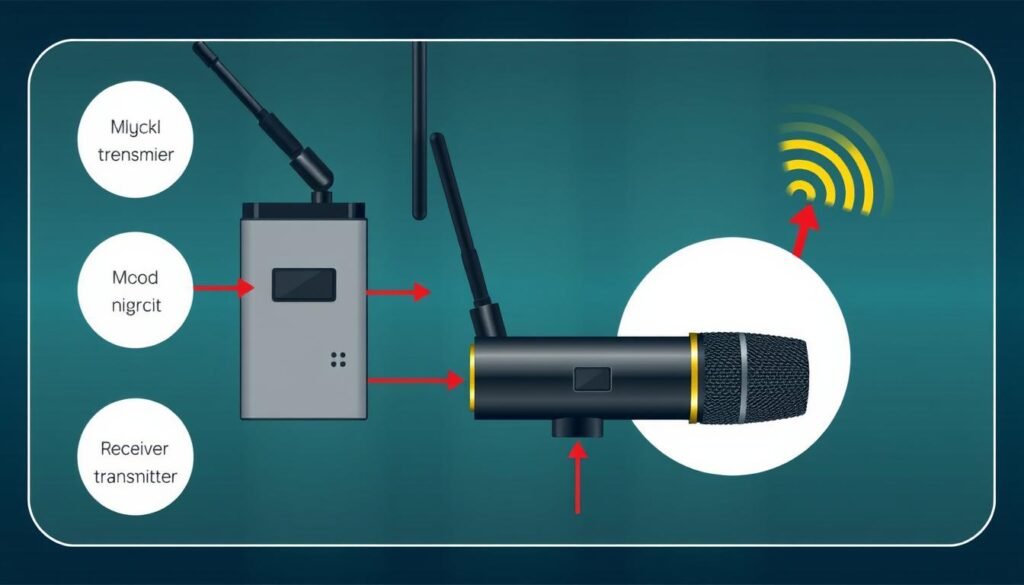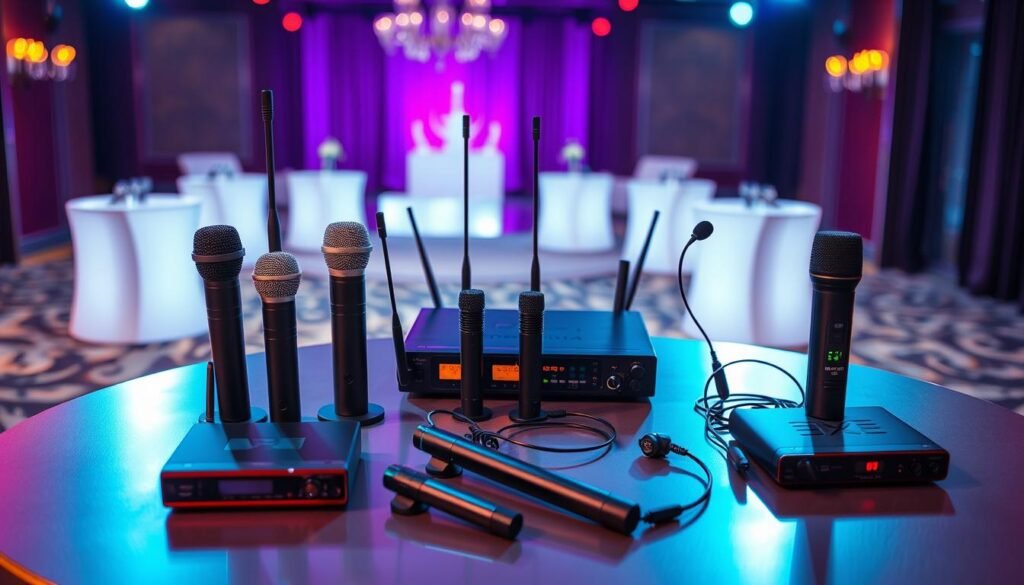מערכות מיקרופון אלחוטי הן חיוניות לייצור אירועים מצוינים. הן מציעות חופש לא מוגבל לדוברים ולמבצעים. מכשירים אלה משפרים את ההשתתפות של הקהל ומאפשרים תנועה חלקה.
מיקרופונים אלחוטיים מסירים את הצורך בכבלים גדולים. זה מפשט את ההתקנה וההפסקה, חוסך זמן. זה גם מפחית סיכוני כישלון בבמה.
התקדמויות טכנולוגיות אחרונות העלו את איכות הקול והאמינות. מיקרופונים אלחוטיים כיום פופולריים לאירועים בכל הגדלים. הם שינו את דרך בה אנו חווים צליל בסביבות שונות.
המכשירים המורחבים הללו מספקים קול ברור עם ניידות ללא הגבלה. הם חיוניים לייצור אירועים מודרניים. מפגשי עסקים ועד להופעות, מיקרופונים אלחוטיים מבריקים.
מסקנות מרכזיות
- מיקרופונים אלחוטיים מציעים חופש תנועה לדוברים ולמבצעים
- הם מפשטים את ההתקנה והפסקה של האירוע על ידי הסרת הכבלים
- טכנולוגיית האלחוט שיפרה איכות קול ואמינות
- גמיש לשימוש בסוגי אירועים וגדלים שונים
- כלי חיוני לייצור אירועים מודרניים ועידוד קהל
היתרונות של השימוש בטכנולוגיית אלחוט
מערכות מיקרופון אלחוטיות שינו את אופן ההפעלה של אירועים. הן מציעות מספר יתרונות שהופכים את האירועים לטובים יותר עבור המרצים והמשתתפים. מערכות אלו מסירות את הגבולות של מיקרופונים חוטיים, מעניקות יותר חופש וחיבור טוב יותר עם הקהל.
ניידות מוגברת עבור מרצים ומבצעים
מיקרופונים אלחוטיים מאפשרים למרצים ולמבצעים לזוז בחופשיות על במה. הם יכולים להתקשר עם הקהל בצורה יותר טבעית וביטויית. החופש הזה עוזר להם להעביר את ההודעה שלהם ביותר התלהבות והשפעה.
מציגים יכולים כעת לזוז סביב ולהתקשר עם הקהל בקלות. זה יוצר חוויה מרתקת יותר ומשאיר רושם אחרון על הקהל.
"מיקרופונים אלחוטיים שינו את הדרך שבה אני מציגה על הבמה. היכולת לזוז בחופשיות ולהתקשר עם הקהל הביאה את ההרצאות שלי לרמה חדשה לגמרי." – שרה תומפסון, דוברת מקצועית
שיפור ההתמודדות עם הקהל
מיקרופונים אלחוטיים עוזרים לדוברים להתחבר בצורה טובה יותר עם הקהל שלהם. המציגים יכולים לנוע בקלות במרחב האירוע ללא מחסומי כבלים. הם יכולים לשאול שאלות, לעשות הדגמות, או לעודד השתתפות בצורה יעילה יותר.
האינטראקציה הזו יוצרת קשר חזק יותר בין הדובר למשתתפים. זה עושה את האירוע יותר טוב וזוכר לכל המעורבים.
התמודדות טובה יותר עם הקהל משפיעה לאורך זמן. המשתתפים יותר סביר שיזכרו את התוכן ויחליפו את החוויות שלהם. הם גם יצפו בקראת אירועים עתידיים בתהליך עם תהיה.
הקמת ופירוק מהירים
מערכות מיקרופון אלחוטיות עוזרות בתכנון של האירוע. הקמת ופירוק הציוד לוקחת פחות זמן ללא כבלים. זה מאפשר למארגנים להתמקד בחלקים חשובים נוספים של האירוע.
היעילות עוזרת במיוחד כאשר מעורבים דוברים מרובים. זה מפחית את זמן ההחלפה ושומר על זרימת האירוע בצורה חלקה. מערכות אלחוטיות גם מורידות את הסיכון לבעיות הקשורות לכבלים.
אין צורך לדאוג לסיכוני כישלון או בעיות טכניות מכבלים פגומים. זה מבטיח חוויית מקצועית יותר לכל מי שנמצא באירוע.
| היתרון | מיקרופונים חוטיים | מיקרופונים אלחוטיים |
|---|---|---|
| ניוד | מוגבל | לא מוגבל |
| אינטראקציה עם הקהל | מינימלית | משופרת |
| זמן התקנה | ארוך | מוקצר |
| בעיות הקשורות לכבל | סיכונים פוטנציאליים | נכחדות |
מערכות מיקרופון אלחוטי מציעות יתרונות ברורים על פני התקנות חוטיות. הן מספקות חוויית יותר טובה למארגנים, דוברים ומשתתפים. שימוש בטכנולוגיית אלחוט מפגין את האירועים כמובילים, יעילים וזוכרים יותר.
סוגי מיקרופונים אלחוטיים
מיקרופונים אלחוטיים מגיעים בשלושה סוגים ראשיים: נייד, לאבלייר, ו- הדסט. כל סוג מציע תכונות ייחודיות לשימושים שונים. בואו נגלות את אפשרויות אלו כדי לעזור לך לבחור את הטוב ביותר עבור צרכיך.
מיקרופונים ניידים
מיקרופונים ניידים אלחוטיים הם גמישים ונפוצים במידה רבה. הם מצוינים לשיחות, ראיונות והופעות. דוברים ומבצעים מרגישים נוח בשימוש בהם, מה שמעלה את ביטחונם.
"מיקרופונים ניידים מאפשרים לך לזוז בין הבמה או המקום, להתעסק עם הקהל וליצור חוויית קיימות יותר." – שרה ג'ונסון, מתאם אירועים
מיקרופונים לאבלייר
מיקרופונים לוולייה, המכונים גם מיקרופונים קליפ או לאפל, הם קטנים ודיסקרטיים. הם מושלמים להרצאות, שיעורים ודיונים בפאנל. מיקרופונים אלו מתקבלים על בגדים ליד הצוואר.
הם מספקים שמע ברור ועקבי תוך ניתוק כמעט מוחלט. זה עושה אותם אידיאליים להגדרות רשמיות.
- אידיאליים להרצאות ושיעורים
- דיסקרטיים וכמעט בלתי נראים
- מספקים שמע ברור ועקבי
מיקרופונים לאוזניות
מיקרופונים לאוזניות מיועדים לשימוש חופשי ידיים. הם פופולריים בקרב מדריכי כושר, מוזיקאים ובמאים. מיקרופונים אלו מספקים שמע ברור ועקבי תוך מענה חופשי.
המיקרופון מונח על הראש, ליד הפה לאיכות צליל מיטבית. עיצוב זה מושלם לדוברים פעילים.
| סוג המיקרופון | מתאים ביותר ל | תכונות עיקריות |
|---|---|---|
| נייד | הרצאות, ראיונות, הופעות | גמיש, מוכר, נוח |
| לאוולייר | הצגות, הרצאות, דיוני פאנל | קטן, דיסקרטי, שמע ברור |
| אוזניית ראש | מדריכי כושר, מוזיקאים, במאים תיאטרליים | חופשי ידיים, שמע עקבי, חופש תנועה |
בחר מיקרופון אלחוטי בהתאם לצרכי האירוע שלך. שקול את דרישות הדוברים או המבצעים. כל סוג מציע יתרונות ייחודיים לאיכות צליל מעולה.
המיקרופון הנכון ישפר את החוויה עבור המציגים וחברי הקהל. בחירתך עשויה לעשות הבדל משמעותי בהצלחת האירוע שלך.
מיקרופונים אלחוטיים: איך הם עובדים
מיקרופונים אלחוטיים שינו את האירועים החיים לתמיד. הם נותנים לדוברים ולמבצעים יותר חופש לתנועה. טכנולוגיה זו משתמשת ב-תדר רדיו (RF) כדי לשלוח אותות שמע ללא חוטים.
המיקרופון ממיר גלי קול לאותות חשמליים. האותות הללו הולכים ל-משדר. ה-משדר יכול להיות במיקרופון או להיות נלבש בנפרד.
ה-משדר משנה את האותות השמע לגלי רדיו. הוא משלח אותם דרך האוויר באמצעות אנטנה.

האות נוסעת על פס תדרים ספציפי. תדרי UHF או VHF הם בחירות נפוצות. תדרים אלו עוזרים להפחתת הפרעות ממכשירים אחרים.
מקלט מקבל את האות הרדיו ליד מערכת הצליל. לאחר מכן הוא משלים את השמע המקורי. מערכת הצליל מחזקת את השמע הזה כדי שהקהל יוכל לשמוע.
מערכות מיקרופון אלחוטי התפתחו באופן משמעותי לאורך השנים, עם מערכות דיגיטליות המציעות כיום איכות צליל משופרת, אבטחה משופרת ועמידות טובה יותר בפני הפרעות בהשוואה לתחרים האנלוגיים שלהן.
הגדרה טובה היא המפתח לעבודת מיקרופונים אלחוטיים ביעילות. הנה כמה דברים חשובים לשקול:
- בחירת פס תדרים וערוץ המתאימים כדי למנוע הפרעות
- מיקום אנטנת המקלט לקבלת האות הטובה ביותר
- ניטור וניהול אורך חיי הסוללה של המיקרופון והמשדר
- ביצוע בדיקות צליל מקיפות ובדיקות לפני האירוע
סוגים שונים של מיקרופונים אלחוטיים מתאימים לצרכים שונים:
| סוג המיקרופון | תכונות | יישומים אידיאליים |
|---|---|---|
| נייד | משדר מובנה בגוף המיקרופון | זמרים, מגישים והשתתפות קהל |
| לאבלייה | מיקרופון קטן, מותקן על הבגד עם משדר גוף | הקלטה דיסקרטית למגישים, שחקנים וטלוויזיה |
| אוזניית ראש | מיקרופון מחובר לכובע ראש עם משדר גוף | דוברים פעילים, מאמני ספורט ומדריכי כושר |
מיקרופונים אלחוטיים יוצרים חוויות מדהימות עבור הקהל. הם מעניקים לדוברים ולמבצעים את החופש להבליט את עצמם. הבנת הטכנולוגיה הזו עוזרת למקצוענים באירועים להשתמש בה בצורה הטובה ביותר.
בחירת מערכת מיקרופון אלחוטי המתאימה
בחירת מערכת מיקרופון אלחוטי מחייבת שקיפות ותשומת לב לגורמים מרכזיים. אלה כוללים טווח תדרים, הפרעות אפשריות, חיי סוללה ומוניטין המותג. בחירה מושכלת מבטיחה ביצועים אופטימליים ואמינות לאירוע שלך.

טווח תדרים והפרעות
טווח התדרים חשוב בעת בחירת מערכת מיקרופון אלחוטי. מערכות שונות פועלות בפסים שונים כמו UHF או VHF. לכל אחת יתרונות וחסרונות משלה.
חשוב לשקול מקורות הפרעה אפשריים במרחב האירוע שלך. אלה עשויים לכלול מכשירים אלחוטיים אחרים או תחנות רדיו קרובות. בחירת מערכת עם טווח תדרים המתאים מפחיתה את סיכוני ההפרעה.
אורך חיי הסוללה ואפשרויות הטעינה
ביצועי הסוללה חיוניים לשמיעה בלתי מופרעת במהלך אירועים. חפש מערכות המציעות אורך חיי סוללה ארוך כדי למנוע כשלי כוח באמצע האירוע. שקול אפשרויות טעינה כמו סוללות נטענות או תחנות עגינה.
תכונות אלה עוזרות לשמור על המיקרופונים שלך מופעלים ומוכנים. הן גם מקלות על תהליך השמירה על הציוד שלך.
מוניטין המותג ותמיכה לקוחות
בחר מותג הידוע באמינות ותמיכה לקוחות מעולה. מותגים מוכרים כמו Shure, Sennheiser ו-Audio-Technica מציעים מערכות מיקרופון אלחוטיות אמינות.
בחירה במותג מובהק מבטיח שהמערכת שלך תבצע כצפוי. זה גם מבטיח גישה לתמיכה רגישה ללקוחות אם יתרחשו בעיות.
"השקעה במערכת מיקרופון אלחוטית אמינה ממותג מהימן יכולה לעשות את כל ההבדל בהצלחת האירוע שלך." – מהנדס קול, ג'ון סמית'
שקול בזהירות
תאימות תדרים, ביצועי סוללה, ו-אמינות המותג. הגורמים הללו משפיעים על איכות צליל ברור ולא מופרע באירוע שלך. הם גם מבטיחים חוויית חלקה למציגים ולמשתתפים כאחד.
שיטות מומלצות לשימוש במיקרופונים אלחוטיים
עקוב אחר שיטות המומלצות לביצוע מיטבי של מיקרופונים אלחוטיים. אלו כוללים טכניקות נכונות לשימוש במיקרופון, טיפוח סוללות, ו-בדיקת אודיו. ההנחיות הללו עוזרות לספק חוויית מקצועית וחלקה לקהל שלך.

מיקום נכון וטיפול במיקרופון
המיקום הנכון מבטיח איכות צליל עקבית וברורה. שמור על מיקרופונים ניידים במרחק של 1-2 אינץ' מהפה שלך. זה מקל על כישור הקול שלך באופן ברור ומפחית את הנשימה.
מיקום מיקרופונים לאוזנייה במרחק של 6-8 אינצ'ים מתחת לסנטר שלך. ודא שהמיקרופון לא נגרר על בגדים או תכשיטים. נסה לא לגעת ברשת המיקרופון או להקשות על המיקרופון.
אם יש צורך לכוון את המיקרופון, עשה זאת בעדינות. כדאי לכוון במהלך ההפסקות בדיבור כדי למזער רעשים לא רצויים.
ניהול סוללות ותוכניות גיבוי
ניהול יעיל של סוללות מונע כשלים של מיקרופונים במהלך אירועים. טען את הסוללות באופן קבוע לפני כל אירוע. החזק סוללות גיבוי במקום להחלפות מהירות.
סובב את הסוללות כדי לוודא שהן נלבשות באופן שווה ומציעות ביצועים אופטימליים. אחסן את הסוללות בצורה תקינה כאשר הן לא בשימוש. יש להכין מיקרופונים אלחוטיים או חוטיים כגיבוי.
בדיקת צליל ובדיקה
הקצה זמן לבדיקת צליל מקיפה לפני כל אירוע. זה עוזר לזהות ולפתור בעיות פוטנציאליות כמו הפרעות או הפסקות. בדוק איכות צליל, עוצמת אות וביצועי סוללה.
בדוק את תגובת התדר והגדרות ה- EQ במהלך בדיקת הצליל. הכוונה המדויקת הזו מבטיחה שהקהל שלך יהנה מצליל איכותי לאורך כל האירוע.
- איכות צליל ובהירות
- עוצמת אות וטווח
- אורך חיי הסוללה וביצועים
- תגובת תדר והגדרות EQ
ביצוע בדיקת צלילים יעילה היא המפתח לאירוע מוצלח. זה מאפשר לך לכוון באופן מדויק את מערכת המיקרופון האלחוטית שלך ומבטיח שהקהל שלך ייהנה מחוויית שמע חלקה ואיכותית.
שיטות אלו עוזרות להפחית בעיות טכניות עם מיקרופונים אלחוטיים. הן מבטיחות שמע מקצועי ואמין לאירועים שלך. עקוב אחריהן לתוצאות הטובות ביותר.
מסקנה
מיקרופונים אלחוטיים מציעים מספר רב של יתרונות למקצוענים בתחום האירועים. הם מספקים ניודות מוגברת ומשפרים את ההשתתפות של הקהל. כלי אלה משפיעים על אירועים דינמיים ומוצלחים יותר.
קיימים סוגים שונים של מיקרופונים אלחוטיים. אלה כוללים מיקרופונים ניידים, לוואלייר ולראש. בחר באפשרות הטובה ביותר לצרכים הספציפיים שלך.
כאשר בוחרים מערכת מיקרופון אלחוטית, חשוב לשקול גורמים מרכזיים. אלה כוללים טווח תדרים, אורך חיי סוללה ושם המותג. אלה הרכיבים מבטיחים ביצועים ואמינות אופטימליים.
ליישום ייעוץ מומלץ לשימוש במיקרופונים אלחוטיים. מיקום נכון וניהול סוללות הם חיוניים. ביצוע בדיקת צליל מקיף הוא חיוני להשגת איכות צליל גבוהה.
טכנולוגיית מיקרופון אלחוטי יכולה לשנות את אירועיך. היא יוצרת חוויות מוקפות ומעוררות עניין עבור הקהל שלך. קבל את החופש והגמישות שהכלים הללו מספקים.
שאלות נפוצות
מהן היתרונות העיקריים של שימוש במיקרופונים אלחוטיים לאירועים?
מהם סוגי המיקרופונים האלחוטיים השונים הזמינים?
איך מיקרופונים אלחוטיים עובדים?
מה צריך לשקול בעת בחירת מערכת מיקרופון אלחוטי?
מהן כמה פרקטיקות מומלצות לשימוש במיקרופונים אלחוטיים במהלך אירועים?
לשיפור ביצועים אופטימליים, יש למקם ולטפל במיקרופונים בצורה תקינה. יש ליישם מערכת ניהול סוללות ולבצע בדיקות צליל מקיפות לפני האירוע. יש לשמור על מרחק ראוי מהפה כדי להפחית רעשי טיפול.
יש לשמור על סוללות חילופיות ולזהות בעיות אפשריות במוקדם. התרגולים הללו יתרמו לחווית אירוע חלקה.
כיצד מיקרופונים אלחוטיים משפיעים על הצלחת האירועים?
מיקרופונים אלחוטיים מעניקים לדוברים ולמבצעים חופש להתעסק עם הקהל. הם מאפשרים הצגות דינמיות ושומרים על איכות צליל גבוהה לאורך כל האירוע. על ידי ייעוץ לוגיסטיקה ושיפור הצליל, מיקרופונים אלחוטיים עוזרים ליצירת אירועים זוכרים ומשפיעים.



